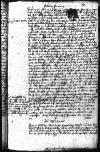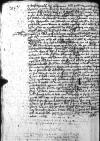Obtinuit contra spectabilem ⌊magistratum civitatis Elbingensis⌋ ⌊Petrus Schissenteuber⌋, concivis eorum, citationem regiam, quam sub mala facta relatione causae impetratam esse non dubito, nam nisi hoc ita factum fuisset, Reverendissima Dominatio Vestra eum facile repulisset. Acta fuit  AAWO, AB, D. 70, f. 317v et decisa haec caus haec causa coram dominis ⌊harum terrarum⌋ ⌊consiliariis⌋ superiori anno in ⌊comitiis⌋ Graudentinis et ibidem etiam per sententiam ms. diffinitivam reg. definitivam⌈diffinitivamms. diffinitivam reg. definitivam⌉ decis pro D ⌊magistratu Elbingensi⌋ latam, decisa. A qua dictus ⌊Schissenteuber⌋ etiam superinscribed in place of crossed-out per me⌈per me etiam etiam superinscribed in place of crossed-out per me⌉ admonitus, appellare noluit, sed dominorum ⌊consiliariorum⌋ decretum in rem iudicatam transire permisit. Postmodum vero, non metu nec quavis alia causa in iure expressa prohibitus, coram notario et testibus appellasse ad serenissimam ⌊maiestatem regiam⌋ di paper damaged⌈[i]i paper damaged⌉citur. Quam ta appellationem nec dominis ⌊consiliariis⌋, nec parti adversae ⌊magistratu Elbingensi⌋ unquam insinuavit, et tamen superinscribed⌈tamentamen superinscribed⌉ sub eius praetextu dictam superinscribed⌈dictamdictam superinscribed⌉ citationem contra magistratum Elbingensem on the margin⌈contra ⌊magistratum superinscribed⌈magistratummagistratum superinscribed⌉ Elbingensem⌋contra magistratum Elbingensem on the margin⌉ impetravit.
AAWO, AB, D. 70, f. 317v et decisa haec caus haec causa coram dominis ⌊harum terrarum⌋ ⌊consiliariis⌋ superiori anno in ⌊comitiis⌋ Graudentinis et ibidem etiam per sententiam ms. diffinitivam reg. definitivam⌈diffinitivamms. diffinitivam reg. definitivam⌉ decis pro D ⌊magistratu Elbingensi⌋ latam, decisa. A qua dictus ⌊Schissenteuber⌋ etiam superinscribed in place of crossed-out per me⌈per me etiam etiam superinscribed in place of crossed-out per me⌉ admonitus, appellare noluit, sed dominorum ⌊consiliariorum⌋ decretum in rem iudicatam transire permisit. Postmodum vero, non metu nec quavis alia causa in iure expressa prohibitus, coram notario et testibus appellasse ad serenissimam ⌊maiestatem regiam⌋ di paper damaged⌈[i]i paper damaged⌉citur. Quam ta appellationem nec dominis ⌊consiliariis⌋, nec parti adversae ⌊magistratu Elbingensi⌋ unquam insinuavit, et tamen superinscribed⌈tamentamen superinscribed⌉ sub eius praetextu dictam superinscribed⌈dictamdictam superinscribed⌉ citationem contra magistratum Elbingensem on the margin⌈contra ⌊magistratum superinscribed⌈magistratummagistratum superinscribed⌉ Elbingensem⌋contra magistratum Elbingensem on the margin⌉ impetravit.
Ne itaque contumaces reputarentur ⌊Magistratus Ged Elbingensis⌋ ⌊Qui⌋ ne contumaces reputarentur, secretarium ⌊eorum⌋ praesentium latorem in ea causa ad ⌊Serenissimam Maiestatem⌋ ⌊tribunal⌋ serenissimae ⌊maiestatis regiae⌋ allegarunt et a me, cum superinscribed in place of crossed-out Quumque⌈Quumque et a me, cum et a me, cum superinscribed in place of crossed-out Quumque⌉ mihi de processu eius causae superinscribed in place of crossed-out huius causae and then crossed-out⌈huius causae eius causae eius causae superinscribed in place of crossed-out huius causae and then crossed-out⌉ constaret, has ad Reverendissimam Dominationem Vestram pro ⌊illis⌋ commendatitias a me rogarunt, quo illa, per me melius superinscribed⌈meliusmelius superinscribed⌉ informata, iustitiae eorum non deesset iustitiae eorum non deesset sed ut, sed tandem adminiculo Reverendissimae Dominationis Vestrae a diuturnis litibus et illius superinscribed⌈illiusillius superinscribed⌉ importuni ⌊hominis⌋ molesta[1] et nullis suffulta do written over u⌈uoo written over u⌉cumentis sen et superinscribed in place of crossed-out et and then crossed-out⌈et sen et sen et superinscribed in place of crossed-out et and then crossed-out⌉ probationibus impetitione auctoritate regia abs liberarentur. Rem igitur superinscribed in place of crossed-out itaque⌈itaque igitur igitur superinscribed in place of crossed-out itaque⌉ ita et non quemadmodum exposuit et non aliter actam esse Reverendissima Dominatio Vestra sibi persuadeat.
Nunc hoc est inventum. Et cum hoc novum sit invent inventum eorum hominum, qui contra constitutiones regias a S ⌊his terris⌋ concessa written over i⌈iaa written over i⌉s ut sportulas, ne sportulas de iudicio deponere appellationum written over , written over is⌈isummum written over , written over is⌉ iudiciis deponere sint obligati, talia re effugia confingunt, plurimum rogo Reverendissimam Dominationem Vestram, velit id efficere, ne quo huiusmodi extraordinariae appellationes, quae frivole et nullis ex ca causis per partes coram notario et testibus, cum tamen coram ordinariis appellare non sint prohibitae, fiunt in a, in aula serenissimae ⌊maiestatis regiae⌋ non recipiantur, nisi prius ostensum fuerit appellationem a dominis ⌊consiliariis⌋ illis de superinscribed⌈dede superinscribed⌉negatam fuisse. Multum hac novitate constitutionibus regiis superinscribed⌈constitutionibus regiisconstitutionibus regiis superinscribed⌉, iudiciis hic nostris et auctoritati eorum detrahitur et lites iam semel superinscribed⌈semelsemel superinscribed⌉ compositae et sopitae renovant ms. revonant(!)
⌈renovantrenovant ms. revonant(!)
⌉ur hidden by binding⌈[ur]ur hidden by binding⌉, partes item superinscribed in place of crossed-out etiam⌈etiam item item superinscribed in place of crossed-out etiam⌉ maxi i written over a⌈aii written over a⌉n faciendis ex expensis plurimum aggravantur hidden by binding⌈[r]r hidden by binding⌉. Quod si per Reverendissimam Dominationem Vestram effectum fuerit Rem itaque omnibus hic gratam est factura Reverendissima Dominatio Vestra, si hoc a serenissima ⌊maiestate regia⌋ impetrare poterit.
Cui me una cum dicto ⌊magistratu Elbingensi⌋ intime commendo atque ut eandem Reverendissimam Dominationem Vestram Deus Omnipotens diu felicem superinscribed in place of crossed-out feliciter⌈feliciter felicem felicem superinscribed in place of crossed-out feliciter⌉ sospitet written over m⌈mtt written over m⌉ et conservet, precor ex animo.
 AAWO, AB, D. 70, f. 317v et decisa haec caus haec causa coram dominis
AAWO, AB, D. 70, f. 317v et decisa haec caus haec causa coram dominis 
